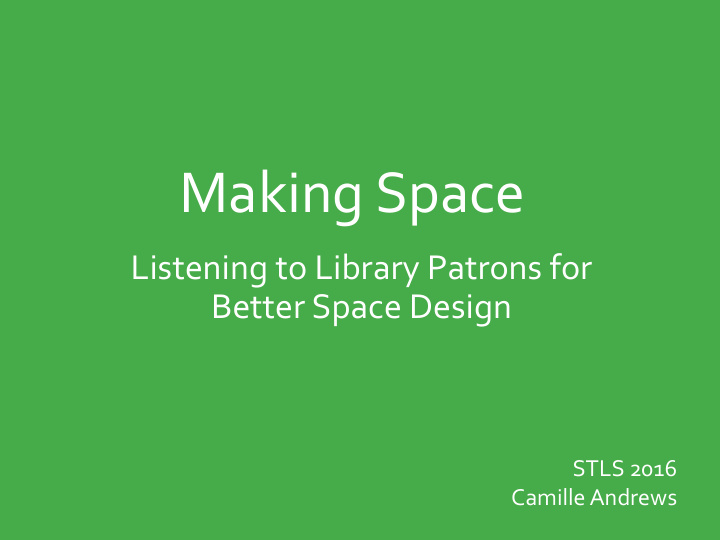



Making Space Listening to Library Patrons for Better Space Design STLS 2016 Camille Andrews
What’s one strategy you have used, if any, to understand your users and/or design your library spaces and services? What questions and concerns do you have about understanding your users and designing your library spaces and services?
moving from this cc: Paul Lowry - https://www.flickr.com/photos/10039026@N03
to this cc: Poughkeepsie Day School - https://www.flickr.com/photos/36258727@N04
how do you know? cc: highersights - https://www.flickr.com/photos/65339210@N02
the usual suspects cc: Sean MacEntee - https://www.flickr.com/photos/18090920@N07
User Experience Design Visceral Behavioral Reflective
User Experience Design • User studies methods like • interviews • observations • ideal space design exercise • photo diaries • usability testing • Design thinking & prototyping cc: mollystevens - https://www.flickr.com/photos/51951260@N00
Design Thinking
Talk to your neighbor about the last place you visited that delighted (or disappointed) you and why
The Mann Experience
• 2014-6 (Consolidation to four floors and further 2 nd floor renovation; First floor service point changes and new consultation area; makerspace) Photo by lietz.photography - Creative Commons Attribution-NonCommercial-ShareAlike License https://www.flickr.com/photos/35018975@N05 Created with Haiku Deck
Draw your ideal collaborative library space (blue sky – no limits on money!)
Feedback at events
WHAT WE DISCOVERED
Space Type Takeaways • Activity zones (individual or group) • Privacy • Different types of spaces for different activities
Variety of space types – from open louder collaborative study space to . . .
traditional quiet reading room
Enclosed or semi-enclosed group rooms/areas
Ambience Takeaways • Aesthetics • Color • Nature & light • Basics
Ambience
Furniture Takeaways • Variety (individual & group) • Privacy & partitions • Comfort • Adjustability & mobility
Technology Takeaways • Low tech v. high tech • Laptops & large/dual screens popular • Easy collaboration
Furniture
Satisfaction after renovation As of 5/20/2014
Challenges • Buy in • What do you want to know? Which method to use? • Getting participation & keeping info • “You are not your user.” • Celebrate failures as well as successes • Logistics (esp. time and money)
UX on a budget
https://www.webjunction.org/explore-topics/smart-spaces.html Grants
• Start small • Listen! • Make incremental changes • Repeat • Communicate and celebrate
New Library Ecosystem http://bit.ly/1bm2jiH
Resources and References Andrews, C., Wright, S. E., & Raskin, H. (2016). Library Learning Spaces: Investigating Libraries and Investing in Student Feedback. Journal of Library Administration , 56 (6), 647 – 672. https://doi.org/10.1080/01930826.2015.1105556 Asher, A., & Miller, S. (2011). So You Want to Do Anthropology in Your Library? or A Practical Guide to Ethnogrpahic Research in Academic Libraries. Retrieved from http://www.erialproject.org/publications/toolkit/ Design Thinking for Libraries: http://designthinkingforlibraries.com/ North Carolina State University, brightspot, AECOM, & Institute of Museum and Library Sciences. (n.d.). Learning Space Toolkit. Retrieved from http://learningspacetoolkit.org/ McArthur, J. A., & Graham, V. J. (2015). User-Experience Design and Library Spaces: A Pathway to Innovation? Journal of Library Innovation , 6 (2), 1. Norman, D. A. (2013). The design of everyday things (Revised and expanded edition.). New York: Basic Books. Norman, D. A. (2004). Emotional design : why we love (or hate) everyday things . New York: Basic Books. Schmidt, A. (2014). Useful, usable, desirable: applying user experience design to your library (First edition). Chicago: ALA Editions, an imprint of the American Library Association. WebJunction’s Resources on Space Planning: https://www.webjunction.org/explore-topics/space-planning.html and Transforming Library Spaces: http://www.webjunction.org/explore-topics/transforming-library-spaces.html
Questions? Camille Andrews ca92@cornell.edu
Recommend
More recommend